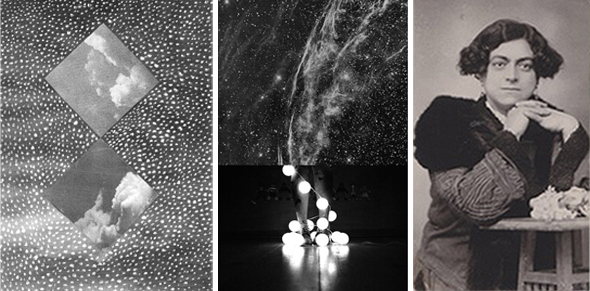מאיה כהן — קילומטרים
חמישי, 22.11.12 | שעה 20:00

אודות התערוכה
התנועה הבלתי פוסקת על מסלול העננים מדריד-תל־אביב וחזרה, גורמת למאיה כהן להתחקות אחרי הווייתה. גרה פה ושם, מכירה פה ושם, פוגשת פה ושם, קונה פה ושם, נושמת פה ושם, אוכלת פה ושם, בוחרת פה ושם. כל פעולה, מחשבה ורגש מוכפלים מעצמם בשני המקומות. החיים הדואליים המאפשרים התנתקות והתחברות על פי בחירה, מעוררים בה את הרצון להגדיר את עצמה על פי המקום והזמן בם היא נמצאת.
כהן מוצאת בעבודות על נייר מצע למציאת הזהות החמקמקה. הנייר המאבד ממעמדו בדפוס, בתקשורת ובמשרד, מוצא עדנה בסטודיו של כהן. תכונותיו כנגיש, קמיט, סופג ונטרלי, מאפשר לה להתבטא באופן חופשי ומשתלח.
כהן מתחילה את תהליך הפירוק העצמי בצילומי 3,547 הקילומטרים המפרידים בין תל אביב למדריד מתוך המטוס. החלל המתועד נגזר לפיסות קומפוזיציה קטנות, משוכפל ומשועתק שוב ושוב בצילומי זירוקס עד שהוא מאבד את ממשיותו וצלמו. ככל שהדימוי משוכפל, מועתק, מודבק, מצויר ומאבד מזהותו, כך כהן מתקרבת לעצמיותה: ישות צעירה שהולכת ושבה בחלל וביקום בטבעיות בוטה.
נעילת התערוכה: 16.12.2012
Maya Cohen — Kilometers
Thursday 22.11.12 | at 20:00
In her journey through the ruins she found ornamental statues dressed in meticulous stone gowns that preserved their charm through time and devastation. Hundreds of spontaneous, extreme close-ups and longshots were hurriedly taken through the distorting lens of accessible technology. Norman found the balance, precision and sentiment between the perfect and crumbling in a statue of Helios – the sun god – with his round, radiant broken face.
She used Tipp-Ex on black paper to immortalize the captivating stone face. Norman has used this technique before but here the use of a limestone derivative was a self-evident bridge between ancient and contemporary art, between the stone’s three dimensionality and the painting’s flatness.
A random visit to Albania, where small towns were built on every hill and cliff – a treasure of historically untended ruins enriched Norman’s stone repertoire. In the Roman temples and Orthodox Byzantine churches even buttresses have hybrid human-animal faces. Norman discovered a unique monstrous humoristic expression: a menacing lion baring his teeth standing on chicken feet; man and woman joined by a mustache. Drawing these figures brought Norman closer to the sculptor and his sentiments when ironically describing heroism, sensuality, sexuality, cruelty and innocence.
Norman’s technique confronts this irony twice. First, when light and image are reversely created: the dark background and the painting radiating from it in white. Next, in the handling of substance: Tipp-Ex dries rapidly dictating swift application with no possibility for repair. To avoid haste, Norman creates puddles of the material on paper, the turpentine evaporates and clouds of diluted material are created on the paper – requiring to be erased for the image to emerge. Erasure exposes the stone faces spreading light and order on the paper. She is like a stonemason shattering his subjects from the stone.
The series reaches a climax when Norman throws her shadow on urban tiles in oil paint applied on wood in a modern, mischievous and ironic response to ancient stone-faces.
Closing: 16.12.12
